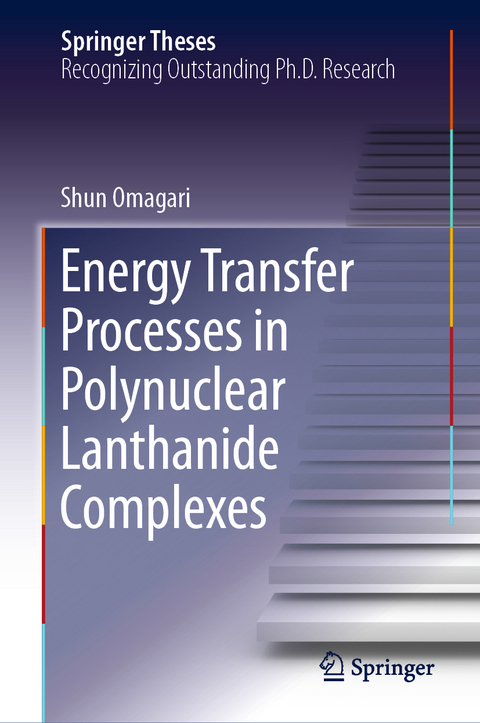
Energy Transfer Processes in Polynuclear Lanthanide Complexes
Seiten
2019
|
1st ed. 2019
Springer Verlag, Singapore
978-981-13-6048-0 (ISBN)
Springer Verlag, Singapore
978-981-13-6048-0 (ISBN)
This book describes the luminescence mechanism of polynuclear lanthanide complexes, focusing on energy transfer processes using a combination of experimental and theoretical approaches.
Lanthanide complexes show intense luminescence from the lanthanide ion through sensitization by the organic ligands.
This book describes the luminescence mechanism of polynuclear lanthanide complexes, focusing on energy transfer processes using a combination of experimental and theoretical approaches.
Lanthanide complexes show intense luminescence from the lanthanide ion through sensitization by the organic ligands. The high chromaticity of the emission and the long lifetimes of the complexes are particularly attractive for applications such as organic light-emitting diodes and bioprobes. Polynuclear lanthanide complexes (coordination polymers and clusters) have attracted considerable interest for functionalization by energy transfer between lanthanide ions. At the same time, such extra processes complicate the luminescence mechanism, hindering the rational design of functional polynuclear lanthanide complexes.
Firstly, the book explains the principle of the theoretical methods, and then describes the concentration-quenching mechanism in coordination polymers. It also examines theeffect of intrinsic spin–orbit coupling arising from lanthanide ions on the ligand-to-lanthanide energy transfer efficiency and the mechanism of back energy transfer (the opposite of sensitizing energy transfer) in lanthanide clusters. This sets the stage for the final topic: the suppression of back energy transfer by energy transfer between lanthanide ions in lanthanide clusters, which is of critical importance, showing that the lanthanide clusters can be considered a new generation of functional and efficient luminescent material and could also provide a breakthrough in lanthanide photophysics.
Lanthanide complexes show intense luminescence from the lanthanide ion through sensitization by the organic ligands.
This book describes the luminescence mechanism of polynuclear lanthanide complexes, focusing on energy transfer processes using a combination of experimental and theoretical approaches.
Lanthanide complexes show intense luminescence from the lanthanide ion through sensitization by the organic ligands. The high chromaticity of the emission and the long lifetimes of the complexes are particularly attractive for applications such as organic light-emitting diodes and bioprobes. Polynuclear lanthanide complexes (coordination polymers and clusters) have attracted considerable interest for functionalization by energy transfer between lanthanide ions. At the same time, such extra processes complicate the luminescence mechanism, hindering the rational design of functional polynuclear lanthanide complexes.
Firstly, the book explains the principle of the theoretical methods, and then describes the concentration-quenching mechanism in coordination polymers. It also examines theeffect of intrinsic spin–orbit coupling arising from lanthanide ions on the ligand-to-lanthanide energy transfer efficiency and the mechanism of back energy transfer (the opposite of sensitizing energy transfer) in lanthanide clusters. This sets the stage for the final topic: the suppression of back energy transfer by energy transfer between lanthanide ions in lanthanide clusters, which is of critical importance, showing that the lanthanide clusters can be considered a new generation of functional and efficient luminescent material and could also provide a breakthrough in lanthanide photophysics.
General Introduction.- Theory.- Concentration Quenching in Ytterbium Coordination Polymers.- Spin-orbit Coupling and Energy Transfer in Nonanuclear Lanthanide Clusters.- Back Energy Transfer in Terbium Clusters.- Suppression of Back Energy Transfer by Energy Transfer between Terbium Ions.- Summary and Outlook.- Acknowledgements.
| Erscheinungsdatum | 02.02.2019 |
|---|---|
| Reihe/Serie | Springer Theses |
| Zusatzinfo | 40 Illustrations, color; 23 Illustrations, black and white; XV, 140 p. 63 illus., 40 illus. in color. |
| Verlagsort | Singapore |
| Sprache | englisch |
| Maße | 155 x 235 mm |
| Themenwelt | Naturwissenschaften ► Chemie ► Anorganische Chemie |
| Naturwissenschaften ► Chemie ► Organische Chemie | |
| Schlagworte | Coordination polymers • Energy transfer • lanthanide complexes • Luminescent Complexes • Terbium Clusters |
| ISBN-10 | 981-13-6048-0 / 9811360480 |
| ISBN-13 | 978-981-13-6048-0 / 9789811360480 |
| Zustand | Neuware |
| Haben Sie eine Frage zum Produkt? |
Mehr entdecken
aus dem Bereich
aus dem Bereich
Buch | Hardcover (2024)
Springer Spektrum (Verlag)
64,99 €


